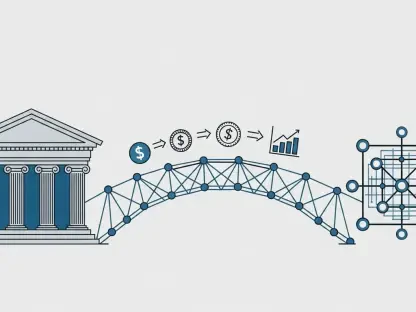In a world where digital transactions have become the lifeblood of commerce, the battle against fraud has reached unprecedented heights, demanding innovative solutions to protect businesses and consumers alike from increasingly sophisticated threats. As industries such as finance, retail, and fintech navigate a landscape riddled with challenges like identity theft, cyberattacks, and financial crimes, the role of fraud prevention companies has never been more vital. The current year marks a pivotal moment where technology, particularly artificial intelligence and machine learning, drives the charge against fraudsters who exploit every digital vulnerability. This article delves into the frontrunners in fraud prevention, spotlighting those organizations that stand out with cutting-edge strategies and tools tailored to meet the diverse needs of modern enterprises. From global banks to nimble startups, the stakes for robust security are sky-high, and choosing the right partner can define success in safeguarding both customer trust and financial stability. The exploration ahead uncovers how these leaders are reshaping the industry with proactive measures and advanced systems, ensuring they stay one step ahead of evolving risks in a relentlessly digital era.
The Transformation of Fraud Defense Strategies
The fraud prevention sector has witnessed a remarkable shift, abandoning outdated, rigid frameworks in favor of agile, data-driven technologies that redefine security standards. Artificial intelligence (AI) and machine learning (ML) now form the core of most solutions, empowering businesses to analyze massive volumes of data in real time. This capability allows for the detection of subtle anomalies and the anticipation of potential threats before they materialize. Unlike older systems that relied heavily on predefined rules, today’s approaches adapt dynamically, learning from new patterns and evolving alongside fraud tactics. This transformation is not merely an improvement but a fundamental necessity as cybercriminals employ increasingly complex methods to bypass traditional defenses. The emphasis on predictive analytics signifies a broader industry trend toward preemption, ensuring that risks are identified and mitigated at the earliest possible stage.
Beyond technology, the modern approach to fraud prevention prioritizes a proactive stance over a reactive one, fundamentally altering how threats are addressed. Innovations like behavioral biometrics, which study user interactions to differentiate legitimate actions from suspicious ones, play a crucial role in this shift. Predictive modeling further enhances this by forecasting fraudulent behavior based on historical data and emerging trends, often catching issues before any damage occurs. This forward-looking mindset is essential in tackling sophisticated schemes such as phishing or social engineering, where attackers exploit human vulnerabilities rather than technical ones. By focusing on prevention, companies can reduce the financial and reputational fallout that often follows a successful attack, positioning themselves as trusted guardians in a digital landscape fraught with peril. This strategic pivot underscores the industry’s recognition that staying ahead of fraudsters requires constant innovation and vigilance.
Emerging Trends Driving Fraud Prevention
One of the most significant trends shaping fraud prevention today is the global scope of threats, necessitating solutions with international capabilities to match the borderless nature of digital crime. Companies that harness extensive worldwide datasets can effectively combat cross-border fraud, providing seamless protection for businesses operating in multiple regions. This global reach is indispensable in an interconnected economy where a single fraudulent transaction can span continents in seconds. Such comprehensive coverage ensures that enterprises, whether in finance or e-commerce, can safeguard their operations regardless of geographic constraints. The ability to monitor and respond to threats on a global scale has become a defining feature of leading providers, setting them apart in a market where localized solutions often fall short against transnational fraud networks.
Another critical trend is the rise of mobile-first security, driven by the surge in smartphone-based transactions and banking activities across the globe. As mobile platforms become the primary channel for financial interactions, the need for specialized protection tailored to these environments grows urgent. Leading companies are developing advanced authentication methods and risk analysis tools specifically for mobile users, addressing vulnerabilities unique to handheld devices. This focus is vital in an era where convenience often trumps security in consumer preferences, yet both must coexist to maintain trust. By prioritizing mobile security, providers ensure that the rapid shift to digital payments does not come at the expense of safety, offering robust defenses against fraudsters targeting this increasingly dominant channel.
Regulatory compliance continues to be a cornerstone of fraud prevention, particularly in sectors like banking and financial services where strict oversight is non-negotiable. Solutions designed to align with standards such as Anti-Money Laundering (AML) and Know Your Customer (KYC) protocols help businesses avoid hefty penalties while fostering confidence among clients and regulators. This alignment is not just about meeting legal requirements but also about building a reputation for reliability in industries where trust is paramount. Providers that integrate compliance into their core offerings enable companies to navigate complex regulatory landscapes without sacrificing operational efficiency. As regulations evolve alongside digital advancements, the ability to stay compliant while delivering effective fraud prevention remains a key differentiator for industry leaders.
Pioneers Setting the Standard in Fraud Prevention
Among the myriad players in fraud prevention, certain companies distinguish themselves through a potent mix of innovative technology and customized solutions that address a wide spectrum of business challenges. Experian emerges as a titan in this space, leveraging its unparalleled data analytics and AI-driven models to deliver real-time monitoring and robust regulatory support. Its integration of behavioral biometrics offers a nuanced layer of protection, identifying fraud through user patterns that deviate from the norm. While this makes Experian a preferred choice for large financial institutions seeking comprehensive security, the associated costs and complexity of implementation may pose barriers for smaller entities. Nevertheless, its ability to handle vast datasets with precision positions it as a benchmark for enterprise-grade fraud defense in a highly competitive field.
Fiserv also commands attention with its specialized focus on financial technology, providing tailored solutions for digital payments, card services, and ATM transactions. Its strength lies in seamless integration with existing banking systems, allowing for smooth deployment without disrupting operations—a critical factor for retail banks and payment providers. The AI-powered scoring tools and predictive analytics embedded in its offerings ensure strong protection across diverse transaction channels. However, much like Experian, Fiserv’s pricing structure tends to favor larger institutions, potentially limiting accessibility for smaller organizations with tighter budgets. Despite this, its expertise in financial transactions makes it an indispensable ally for enterprises handling high volumes of digital payments in an increasingly cashless society.
LexisNexis Risk Solutions sets itself apart with an extraordinary depth of data intelligence, drawing from billions of global records to fuel its fraud prevention capabilities. Its multi-layered authentication processes and risk scoring mechanisms are particularly effective in meeting AML and KYC compliance needs, making it a trusted name in finance, insurance, and healthcare. The platform’s ability to provide predictive fraud detection across industries underscores its versatility, though the complexity of setup and cost considerations may deter smaller firms from adopting its solutions. For enterprises requiring deep regulatory support and extensive fraud intelligence, LexisNexis remains a formidable choice, offering insights that are both actionable and far-reaching in scope.
Tailored Approaches for Specific Challenges
Socure has rapidly gained prominence by focusing on AI-driven identity verification, particularly appealing to fintech companies and digital-first businesses aiming for frictionless customer experiences. Its predictive analytics and biometric authentication tools enhance the accuracy of onboarding processes while significantly reducing fraud-related losses. This dual focus on security and user convenience addresses a critical pain point in industries where customer retention often hinges on ease of use. While Socure’s solutions excel in digital environments, some businesses may find that deployment requires tailored adjustments to fully align with their systems. For organizations prioritizing seamless onboarding alongside robust protection, Socure stands out as a forward-thinking partner in navigating the complexities of digital identity fraud.
In contrast, OneSpan hones in on authentication and mobile security, catering specifically to the needs of digital banking with an emphasis on strong customer authentication and transaction risk analysis. Its adherence to global regulations such as Payment Services Directive 2 (PSD2) and AML standards is a significant advantage, ensuring compliance while bolstering security. However, its concentrated focus on the banking sector may limit its applicability to other industries seeking broader fraud prevention tools. For financial institutions prioritizing mobile-first security, OneSpan offers specialized expertise that aligns with the growing reliance on mobile transactions, providing a safeguard against the unique threats posed by this platform.
Other notable leaders, such as FIS Global, IBM, SAS Institute, and GBG, further illustrate the diversity within the fraud prevention landscape, each bringing distinct strengths to the table. FIS Global excels in end-to-end security for payment ecosystems, while IBM offers customizable, AI-integrated platforms for enterprise-grade protection across sectors. SAS Institute stands out with its analytics-driven approach to multi-channel fraud detection, and GBG focuses on digital identity verification for secure onboarding. This variety ensures that businesses, regardless of size or industry, can find a provider whose solutions match their specific vulnerabilities and operational demands, highlighting the tailored nature of modern fraud prevention strategies.
Balancing Security with Business Growth
A recurring theme among top fraud prevention companies is the delicate balance between stringent security measures and the need to maintain a positive customer experience, a challenge that shapes much of their innovation. Solutions are increasingly designed to minimize friction—such as during customer onboarding or transaction processing—without compromising on protection. This equilibrium is particularly crucial in digital-first industries like fintech, where a cumbersome process can drive users to competitors. Leading providers recognize that security should not come at the cost of convenience, and their ability to streamline interactions while thwarting fraud is a key competitive edge. This focus ensures that businesses can protect their assets and reputation without alienating the very customers they aim to serve.
Cost and accessibility also play significant roles in the adoption of fraud prevention tools, often creating a divide between large enterprises and smaller businesses in terms of implementation. Many top-tier solutions, while highly effective, carry price tags and technical requirements that cater primarily to organizations with substantial resources. Smaller firms, equally vulnerable to fraud, may struggle with the financial and logistical hurdles of deploying such systems. This disparity highlights an ongoing challenge within the industry to develop scalable, affordable options that do not sacrifice efficacy. As the market evolves, addressing this gap could unlock broader access to advanced fraud prevention, ensuring that security is not a privilege reserved for the largest players but a right for all businesses navigating the digital economy.
Looking Ahead to Sustained Innovation
Reflecting on the strides made by fraud prevention companies, it’s evident that the industry has reached a turning point where reactive measures have given way to proactive, technology-driven defenses. The leaders—Experian, Fiserv, LexisNexis Risk Solutions, TransUnion, Socure, OneSpan, and others like FIS Global, IBM, SAS Institute, and GBG—have set a high bar with their integration of AI, real-time monitoring, and tailored security solutions. Their efforts have not only countered sophisticated threats but also reshaped how businesses approach risk in a digital age, prioritizing prevention and compliance alongside user experience. This collective push has fortified industries against the relentless creativity of fraudsters, proving that innovation is the most powerful weapon in this ongoing battle.
Moving forward, businesses must consider aligning with these top providers to bolster their defenses, focusing on solutions that match their scale and specific risks. Exploring partnerships with companies offering scalable tools could bridge the accessibility gap for smaller entities, while larger organizations might invest in customizable platforms to address complex needs. Staying abreast of emerging technologies, such as advancements in behavioral biometrics or mobile security, will be crucial for maintaining a competitive edge. Additionally, fostering a culture of continuous adaptation ensures that defenses evolve alongside threats. As the digital landscape expands, collaboration between businesses and fraud prevention leaders will be key to building a resilient future, where security and growth go hand in hand.









